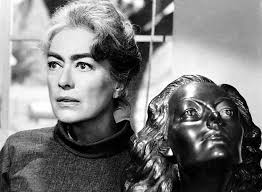
William Castle took over (unofficially) for Curt Siodmak in the campy horror genre in the late 1950s. Castle directed such pictures as 13 Ghosts, Mr. Sardonicus, and The Tingler. All his films of this type were alike in that they featured some sort of audience participation gimmick. 13 Ghosts was shown in something called “Illusion-O”, a sister to 3-D, that required flimsy glasses to create the desired effect. Patrons of The Tingler no doubt remember being “pinched” by the specially installed seats, made to make the audience yelp during the film.
Strait-Jacket seems to be an attempt to make legitimate fare out of clearly gory thriller elements (although patrons were given cardboard axes to swing during the movie). Joan Crawford, having just come off of Whatever Happened to Baby Jane?, signed on to work with Castle on this picture. She retained most of the control, however, getting final cast and script approval, and bringing her own light crew and hair and makeup department.
The story revolves around Lucy (Crawford) who finds her no-good husband (Lee Majors, uncredited) in bed with another woman. Overcome with anger, she grabs a wood axe and chops them to pieces while they sleep. Her daughter Carol (Diane Baker), about age 7, witnesses the gruesome scene. After her mother is sent to an asylum, she goes to live with her aunt and uncle in the country. 20 years later, Lucy is released and goes to live with the happy three on the farm. Not surprisingly, Lucy has trouble adjusting to society, particularly to her daughter’s soon-to-be fiance, Michael, and his family. Then, people start dying and disappearing and Lucy is suspected.

Anyone who has seen Hitchcock‘s Psycho will recognize this contains similar tropes — because it shares the screenwriter. Dr. Anderson (Mitchell Cox, president of Pepsi at the time), her rehabilitation specialist, is just like Detective Arbogast. Michael is similar to Janet Leigh‘s boyfriend. Even Carol resembles Vera Miles in her gentle, sweet demeanor. Down to the last moment, with the tacked-on clumsy, expositional ending, it echoes of Psycho. But the quietness of Hitchcock‘s film is nowhere to be found. Strait-Jacket is choppy, brazen and ragged. Out of place theremin music punctuates at odd moments – as if the sight of Crawford’s falling face, starkly lit, wielding an axe needed accentuating.
As much as this film pretends to be a gore fest, it is really about people desperately clinging to something that is slipping away. Carol is holding onto the idea of a lost mother, and her chance of happiness with her fiance. The aunt and uncle want to see life continue as it was before Lucy arrived. Michael’s parents are determined to keep their son away from such a low-brow family. Lucy is trying to cling to her last bit of sanity, and hope for a normal life.
Most of all, it is clear that Joan Crawford is clinging to a level of stardom that began to crumble as her age began to creep across her face. She is desperate to prove her staying power as an A-list actress in a B movie. She brings the same gravity that she showed in Mildred Pierce and Harriet Craig. But in her eyes, the frailty is not just her character’s. Her struggle and determination are evident. Strait-Jacket is an enjoyable, if not perfect, picture — for its campiness and to see Crawford fighting to stay on top.
